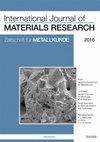由部分氧化和金属间相形成诱发的轻质、高硬度多组分体系的制备
IF 0.7
4区 材料科学
Q4 METALLURGY & METALLURGICAL ENGINEERING
引用次数: 0
摘要
采用机械合金化的方法,在贫氧气氛下制备了三元Mg-Al-Ti和季相Mg-Al-Ti - cu体系,并进行了放电等离子烧结。在750℃下烧结16 h的三元Mg-Al-Ti和季相Mg-Al-Ti - cu体系的最高硬度分别为509和947 HV,低密度分别为2.9和3.9 g/cm3。通过优化MA工艺,使颗粒尺寸减小,元素分散均匀,SPS后形成了均匀的复合组织。此外,第四元素Cu的加入对硬度的提高有显著的影响。从微观结构和元素的电子性质两方面解释了这一结果。我们的研究结果提供了一种简便的方法来合成氧化物/金属复合材料从元素粉末没有单独的氧化过程。本文章由计算机程序翻译,如有差异,请以英文原文为准。
Preparation of lightweight, high hardness multi-component systems induced by partial oxidation and hard intermetallic phase formation
The ternary Mg–Al–Ti and quaternary Mg–Al–Ti–Cu systems were prepared by mechanical alloying in oxygen-lean atmosphere followed by spark plasma sintering. The ternary Mg–Al–Ti and quaternary Mg–Al–Ti–Cu systems which were sintered at 750 °C after 16 h milling showed the highest hardness of 509 and 947 HV with low densities of 2.9 and 3.9 g/cm3, respectively. The decrease in particle size and uniform dispersion of elements through optimization of the MA process induced the formation of uniform composite microstructure after SPS. Moreover, the addition of the fourth element, Cu, showed a significant impact on the improvement in hardness. This result was explained from the perspective of the microstructure and the electronic nature of elements. Our results provide a facile method for synthesizing oxide/metal composites from elemental powders without a separate oxidation process.
求助全文
通过发布文献求助,成功后即可免费获取论文全文。
去求助
来源期刊
CiteScore
1.30
自引率
12.50%
发文量
119
审稿时长
6.4 months
期刊介绍:
The International Journal of Materials Research (IJMR) publishes original high quality experimental and theoretical papers and reviews on basic and applied research in the field of materials science and engineering, with focus on synthesis, processing, constitution, and properties of all classes of materials. Particular emphasis is placed on microstructural design, phase relations, computational thermodynamics, and kinetics at the nano to macro scale. Contributions may also focus on progress in advanced characterization techniques. All articles are subject to thorough, independent peer review.

 求助内容:
求助内容: 应助结果提醒方式:
应助结果提醒方式:


